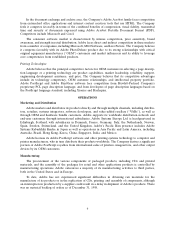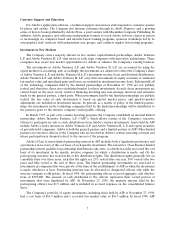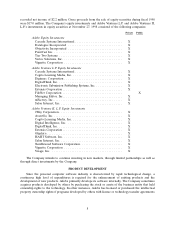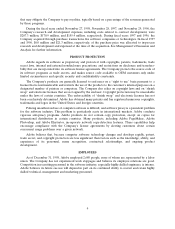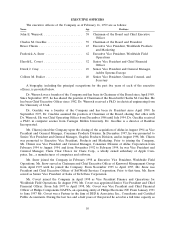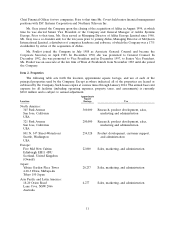Adobe 1998 Annual Report Download - page 16
Download and view the complete annual report
Please find page 16 of the 1998 Adobe annual report below. You can navigate through the pages in the report by either clicking on the pages listed below, or by using the keyword search tool below to find specific information within the annual report.
(4) imagesetters; (5) screen displays; and (6) digital copiers. Adobe PostScript products serve the corporate
enterprise, graphic arts, production printing, small office/home office, and high-volume production print-
ing markets. Licensing revenue is also derived from shipments of products containing the Configurable
PostScript Interpreter (‘‘CPSI’’) by OEM customers. CPSI is a fully functional Adobe PostScript inter-
preter that resides on the host computer system rather than in a dedicated controller integrated into an
output device. The configuration flexibility of CPSI allows OEM customers and software developers to
create and market a variety of Adobe PostScript products independently of controller hardware
development.
Licensing revenue in fiscal 1998 decreased $32.1 million, or 16%, compared to fiscal 1997, primarily
due to weakness in the Japanese personal computer and printer markets, as well as a reduction in royalty
revenue from Hewlett-Packard Company’s (‘‘HP’’) desktop monochrome laser printer division which has
been incorporating a clone version of Adobe PostScript into some of its products since the fall of 1997.
Licensing revenue in fiscal 1997 was unchanged from fiscal 1996 as increased demand for CPSI, color
capability, and Adobe PrintGear products was offset by a number of factors affecting OEM customers,
primarily in the Japanese and Macintosh markets. These factors included, but were not limited to,
continuing weakness in Macintosh-related printer sales and in Japanese personal computer and printer
markets, as well as a slow pace of certain new technologies being brought to market by OEM customers.
The Company continues to be cautious about licensing revenue in the short term because of Japanese
market conditions, the uncertain timing of new product releases by OEM customers incorporating Adobe’s
latest technologies, and the anticipated full impact of loss of revenue from HP’s monchrome laser printer
products. In addition, OEM customers on occasion seek to renegotiate their royalty arrangements. The
Company evaluates these requests on a case-by-case basis. If an agreement is not reached, a customer may
decide to pursue other options, which could result in lower licensing revenue to the Company. As a result
of these conditions, the OEM licensing business is likely to decline in fiscal 1999. However, the Company
anticipates growth opportunities in the digital copier marketplace that are expected to increase licensing
revenue in the long term.
1998 Change 1997 Change 1996
Product revenue:
Application products .......................... $730.6 2% $715.7 21% $589.9
Percentage of total revenue ....................... 81.7% 78.5% 75.0%
Application products revenue is derived predominantly from shipments of application software
programs marketed through retail and VAR distribution channels, with the exception of Adobe
PhotoDeluxe, which is primarily distributed through OEM bundling agreements with digital camera,
scanner, and personal computer manufacturers.
Application products revenue increased $15.0 million, or 2%, in fiscal 1998 compared to fiscal 1997,
due primarily to the release of two major professional publishing products, Adobe Photoshop 5.0 and
Adobe Illustrator 8.0; increased revenue from Acrobat 3.0, as the Portable Document Format (‘‘PDF’’)
upon which Acrobat is based continued to gain acceptance worldwide; and increased revenues from the
Company’s new Web products, Adobe ImageStyler and Adobe ImageReady, which have received favorable
reviews and market reception. In addition, the release of Adobe PhotoDeluxe Business Edition and Adobe
Premiere 5.0, the Company’s video editing product, contributed to the overall increase in application
products revenue. These increases were partially offset by a decline in revenues from various products,
primarily Adobe PageMaker, Adobe FrameMaker and Adobe Type Manager, all of which did not release
upgrades during the year. Overall, the Company’s revenue increase was smaller than expected as a result of
adverse economic conditions in Japan.
16


